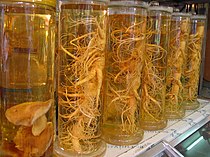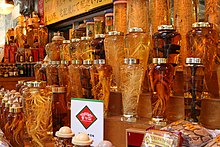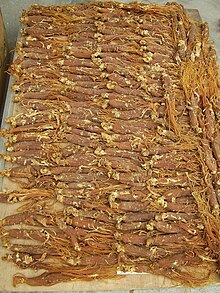Botanical Classification
| Family | Araliaceae |
| Genus and specie | Panax ginseng |
Other names
Man root, root of immortality, Tartar root and life root.American ginseng refers to Panax quinquefolius.
Description of the herb
It is a perennial geophyte with a short rhizome attached to a fleshy root and has a single stem that emerge every year, with compound leaves and a single cluster of small white flowers that develop into bright red fruit.Parts used
The fresh or dried root is used.Properties
It is a sweet tonic herb that both stimulates and relaxes the nervous system and encourage the secretion of hormones, improves stamina, lowers blood sugar as well as cholesterol levels and increases resistance to disease.It contains at least 18 triterpenoid saponins, called ginsenosides or panaxosides and they are glycosides of oleanolic acid, 20-S-protopanaxdiol, ginseng polysaccharides (panaxans), pectin, free sugar, vitamins B1, B2, B12, nicotinic acid, pantothenic acid, biotin, choline, fats, minerals and polyacetylenes.
Common classification
P. quinquefolius American ginseng (root)
According to traditional Chinese medicine, American ginseng promotes yin energy, cleans excess yang and calms the body. The reason it has been claimed that American ginseng promotes yin (shadow, cold, negative, female) while Asian ginseng promotes yang (sunshine, hot, positive, male) is because, according to traditional Chinese medicine, things living in cold places or northern side of mountains or southern side of rivers are strong in yang and vice versa, so that the two are balanced.[citation needed] Chinese/Korean ginseng grows in Manchuria and Korea, the coldest area known to many Koreans in ancient times. Thus, ginseng from there is supposed to be very yang.Originally, American ginseng was imported into China via subtropical Guangzhou, the seaport next to Hong Kong, so Chinese doctors believed American ginseng must be good for yin, because it came from a hot area. They did not know, however, that American ginseng can only grow in temperate regions. Nonetheless, the root is legitimately classified as more yin because it generates fluids.
The two main components of ginseng are claimed to be in different proportions in the Asian and American varieties, and are speculated to be the cause of the excitatory versus tonic natures.The ginseng is traditionally hewn and a few slices are simmered in hot water to make a decoction.
Most North American ginseng is produced in the Canadian provinces of Ontario and British Columbia and the American state of Wisconsin, according to Agri-food Canada. P. quinquefolius is now also grown in northern China.
The aromatic root resembles a small parsnip that forks as it matures. The plant grows 6 to 18 inches tall, usually bearing three leaves, each with three to five leaflets two to five inches long.
Panax ginseng Asian ginseng (root)
- The form called fresh ginseng is the raw product.
- The form called white ginseng (WG) is fresh ginseng which has been dried. It is grown for four to six years, and then peeled and dried to reduce the water content to 12% or less. White ginseng is air dried in the sun and may contain less of the therapeutic constituents. It is thought by some that enzymes contained in the root break down these constituents in the process of drying. Drying in the sun bleaches the root to a yellowish-white color.
- The form called red ginseng (RG) is harvested after six years, is not peeled and is steam-cured at standard boiling temperatures of 100 °C (212 °F), thereby giving it a glossy reddish-brown color. Steaming the root is thought to change its biochemical composition and also to prevent the breakdown of the active ingredients. The roots are then dried. RG is more common as herbal medicine than WG, and there is increasing research on the pharmacological activities of RG specific ginsenoside.
- The form called sun ginseng (SG) is created from a heat processing method which increases ginsenoside components such as ginsenoside-[Rg.sub.3], -[Rk.sub.1] and -[Rg.sub.5] by steaming white ginseng at a higher temperature than red ginseng. The herb is steamed for three hours at 120 °C (248 °F). Research has shown that SG has increased nitric oxide, superoxide, hydroxyl radical and peroxynitrite scavenging activities compared with conventionally processed RG or WG. The increased steaming temperature produces an optimal amount of biological activity due to its ability to amplify specific ginsenosides. Japanese researchers set out to investigate the antioxidant effect of SG on oxidative stress.
Red ginseng
Red ginseng (Hangul:; Hanja: ; RR: hong-sam, simplified Chinese:; traditional Chinese:; pinyin: hóng sēn), is Panax ginseng that has been heated, either through steaming or sun-drying. It is frequently marinated in an herbal brew which results in the root becoming extremely brittle. This version of ginseng is traditionally associated with stimulating sexual function and increasing energy. Red ginseng is always produced from cultivated roots, generally from Korea.
In 2002, a preliminary double-blind, crossover study of Korean red ginseng's effects on impotence reported that it can be an effective alternative for treating male erectile dysfunction, during which 60% of study participants noted an improvement in ability to produce an erection.
Another study reported red ginseng reduced the relapse of gastric cancer versus control.
A study of ginseng's effects on rats found that while both white ginseng and red ginseng appear to reduce the incidence of cancer, the effects appear to be greater with red ginseng.
A study by Sung H, Jung YS, Cho YK. showed potentially beneficial effects of a combination of Korean red ginseng and highly active antiretroviral therapy in HIV-1-infected patients.
Falcarinol, a seventeen-carbon diyne fatty alcohol was isolated from carrot and red ginseng, and was thought to have potent anticancer properties on primary mammary epithelial (breast cancer) cells. Other acetylenic fatty alcohols in ginseng (panaxacol, panaxydol and panaxytriol) have antibiotic properties.
Wild ginseng
Wild ginseng is that which grows naturally and is harvested from wherever it is found to be growing. Wild ginseng is relatively rare, and even increasingly endangered, due in large part to high demand for the product in recent years, which has led to the wild plants being sought out and harvested faster than new ones can grow (it requires years for a root to reach maturity). Wild ginseng can be either Asian or American, and can be processed to be red ginseng.
There are woods-grown American ginseng programs in Maine, Tennessee, Virginia, North Carolina, West Virginia and Kentucky, and United Plant Savers has been encouraging the woods planting of ginseng both to restore natural habitats and to remove pressure from any remaining wild ginseng, and they offer both advice and sources of rootlets. Woods-grown plants have a value comparable to wild-grown ginseng of similar age.
Therapeutic uses 
- Internal use
- It is used internally for debility associated with old age and illness.
- Studies have shown that it improves mood, physical and intellectual performance and other metabolic parameters.
- Furthermore, ginseng is used for lack of appetite, stress, insomnia, chronic illness.
- It is believed to be a powerful adaptogenic aphrodisiac that will affect any system in the body that is out of balance. In Chinese medicine it is used to quickly restore homeostasis (balance) reducing the effect of aging and enhance physical, sexual and mental performance whilst increasing energy and resistance to the harmful effect of stress - and for these reasons it is often used to help men with impotence and sexual problems, and is a good general tonic.
- Ginseng is reported to possess hormone-like and cholesterol-lowering effects, promote vasodilatation, and also act as an anxiolytic as well as antidepressant.
- Some studies have ginseng extracts and ginsenosides to be effective in stimulating learning, memory, and physical capabilities as well as supporting radioprotection, providing resistance to infection and having excellent antioxidant and anti-fatigue effects.
- It is also used to enhance energy metabolism and reducing cholesterol and triglycerides while elevating HDL levels.
- External use
- Ginseng is used in cosmetics for its rejuvenating properties.
- The administration of Ginseng has been clearly associated with obvious improvements in the general metabolism. The herb has a beneficial effect on circulation and the plant regulates the tone of the smooth muscles of the blood vessels.
- There are a very large number of studies which show the action of Ginseng on specific body functions; its stimulating effect on the immune system has been described and also the way it stimulates protein synthesis and inhibits proteic enzymatic degradation in the fibroblasts.
- The plant is responsiblefor increasing phospholipid synthesis in the blood, inhibiting ATPase in the brain and many other effects.
- It has also been shown that Ginseng has a strong anti-radical effect, which is more considerable in derivatives of protapanaxatriol than in other fractions of the plant.
- This vast amount of properties give Ginseng an almost unlimited use in cosmetics. Its activity makes it useful in nourishing creams, in treating wrinkled and aged skin and in all cosmetic products used to retard the onset of age.
- In body milks and bath products, Ginseng acts by optimizing the cutaneous metabolism of the whole body and in capillary products, Ginseng may be used in treatment products for weak hair and lotions for preventing hair loss as it stimulates growth and gives strength.
- Aromatherapy and essential oil use
- None noted.
Safety precautions and warnings 
May worsen the side effects of stimulants such as coffee, and should best be avoided when consuming alcohol.Not normally used by pregnant women and is not indicated for use by young children, people suffering from depression, high blood pressure, anxiety or any acute inflammatory disease.
Excess may cause headaches, restlessness, high blood pressure and nausea.\
Side effects
According to a Sports Nutrition FAQ published by UMass Amherst, one of P. ginseng's most common side effects is the inability to sleep. However, other sources state ginseng causes no sleep difficulties. Other side effects can include nausea, diarrhea, headaches, nose bleeds, high blood pressure, low blood pressure, and breast pain. Ginseng may also lead to induction of mania in depressed patients who mix it with antidepressants.
Ginseng has been shown to have adverse drug reactions with phenelzine and warfarin, but has been shown to decrease blood alcohol levels.
Overdose
The common adaptogen ginsengs (P. ginseng and P. quinquefolia) are generally considered to be relatively safe even in large amounts. One of the most common and characteristic symptoms of acute overdose of Panax ginseng is bleeding. Symptoms of mild overdose with Panax ginseng may include dry mouth and lips, excitation, fidgeting, irritability, tremor, palpitations, blurred vision, headache, insomnia, increased body temperature, increased blood pressure, edema, decreased appetite, increased sexual desire, dizziness, itching, eczema, early morning diarrhea, bleeding, and fatigue.Symptoms of gross overdose with Panax ginseng may include nausea, vomiting, irritability, restlessness, urinary and bowel incontinence, fever, increased blood pressure, increased respiration, decreased sensitivity and reaction to light, decreased heart rate, cyanotic (blue) facial complexion, red facial complexion, seizures, convulsions, and delirium.
Patients experiencing any of the above symptoms are advised to discontinue the herbs and seek any necessary symptomatic treatment.
References
http://en.wikipedia.org/wiki/Ginseng
http://www.ageless.co.za/herb-ginseng.htm




No comments:
Post a Comment